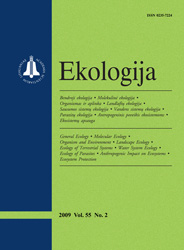 ISSN 0235-7224 ISSN 2029-0586 (online) |
2009 m. Nr. 1 Effect of long-term industrial pollution on soil microorganisms in deciduous forests situated along a pollution gradient next to a fertilizer factory: 1. Abundance of bacteria, actinomycetes and fungi
Soil fungi, bacteria and actinomycetes were studied in seven unequally polluted forest plots situated at different distances from a fertilizer factory in Lithuania. Average numbers of colony forming units in 1 g of dry weight soil (CFU g–1) were determined by plate count on appropriate media: fungi on malt extract agar (MEA), bacteria on nutrient agar (NA), and actinomycetes on starch-casein agar (SCA). During the investigation period (2001–2002), the concentration of viable fungi varied from 23.3 to 387.9 thousand, bacteria – from 380.2 thousand to 9.02 million, and actinomycetes – from 0.11 to 7.58 thousand CFU g–1 of soil. Negative correlation between the fungal and actinomycetal concentrations and the distance from the pollution source (r = –0.56 and r = –0.05, respectively) was determined. Content of some heavy metals (Cu, Cr, Cd, Ni and Zn) in soil positively correlated with the humus content, but did not correlate with the distance from the pollution source. The highest concentration of heavy metals was determined in the soil of the plot situated at a distance of 5 km from the pollution source. Significant and high positive correlation between the fungal concentration and nitrogen (r = 0.77), phosphorus (r = 0.88) and humus (r = 0.74) content in soil was determined. The lowest number of fungal genera was determined in the forest plots where contents of the heavy metals (especially Pb, Cr, Zn and As), nutrients (nitrogen, phosphorus), and humus in soil were the highest. The results showed that abundance of bacterial and fungal populations increased within factory-induced soil pollution, but the diversity of species was decreased. Keywords: soil pollution, heavy metals, microbial counts, bacteria, fungi, actinomycetes |
Issues:
2011 - Vol.57 No. 1, No. 2 2010 - Vol.56 No. 1-2, No. 3-4 2009 - Vol.55 No. 1, No. 2, No. 3-4 2008 - Vol.54 No. 1, No. 2, No. 3, No. 4 2007 - Vol.53 No. 1, No. 2, No. 2.priedas, No. 3, No. 4 2006 No. 1, No. 2, No. 3, No. 4 2005 No. 1, No. 2, No. 3, No. 4 2004 No. 1, No. 2, No. 3, No. 4 2003 No. 1, No. 2, No. 3, No. 4 2002 No. 1, No. 2, No. 3, No. 4 2001 No. 1, No. 2, No. 3, No. 4 |